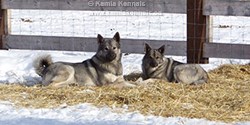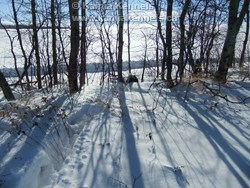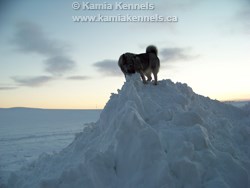Takoda - Kamia Kennels
I am going to tell a story about a once in a lifetime observation in the Canadian World of Elkhounds. Elkhounds are centuries old, with Canadians raising these dogs only for a very small portion of the vast time they have been around. We truly don't have the experience and lifetime knowledge of the situations and the need for different types, we really couldn't fully appreciate what the old breeders went through and what they experienced in the old days when you spent considerably more time with your dog in day to day life activities.
We knew from stories and events recounted that the taller dog evolved out of required need, but a true appreciation of this we really did not have until this winter. A full real understanding is now ours, and I wouldn't doubt we are one of only a handful of Canadians, if not the only ones who have actually experienced this need, and saw the results of this breeding at work, considering there are only a limited number of
Swedish Elkhounds in Canada, and to actually have the two types and experience what we did with the snow level, again, this is most likely a once in a lifetime observation and we are probably the only breeders who have seen it.
In any other year you couldn't see the impact that the extra height has in working in deep snow because we did not get the snow. Takoda is considerably taller and longer than Mia. Mia is on breed standard for height, length and weight, and Takoda being a
Swedish Elkhound is on standard, or slightly above the so called standard for that strain or type. Now, what I need to clarify is that in Canada we only recognize 1 type, so in reality, for the
Norwegian standard he is way bigger.
What the breeders in the old country were trying to accomplish is in the Northern regions where the snow was deeper, they found that the dogs moved easier with slightly longer legs and slightly longer bodies, and with that came some increased size. For most of us, we don't hardly ever get the opportunity to fully appreciate this difference. We could have been raising dogs for years and never really had the chance to see it if the snow hadn't came down in such quantity this year.
Also, if we did not have both types we would never had noticed the difference between the two. If you had two Norwegian's you would have been none the wiser, and there would have been no evidence that the old concepts and theory and idea's were valid and easily proved and advantageous. Now, again here in Canada, both these are Norwegian but we know and are fully aware there are two types.
Let me explain a bit more about this reason why over the centuries the breeders moved toward two types. Again it comes back to movement in the snow, and we literally could not believe the difference this winter. On low snow cover, or for that matter no cover such as the summer and fall, the dogs move effortlessly and it's hard to see a real difference in speed or movement ease, sure you can see in a long run the taller dog over takes the shorter but for the most part in every day movement they are equal. However in deep snow this difference in height becomes so pronounced it's not even close.
Takoda can burn through deep snow at 3 to 4 times the speed of Mia, not because she lacks any power or agility, it's just she has to literally jump out of the snow at each leap, and for the most part never actually gets out of it. She is in snow almost all the time. Takoda on the other hand can come completely out, his belly would be above the snow, his leap is not held by any drag and his added length would propel him far beyond what Mia could ever reach in length.
It was fascinating to watch the two run across the field, he could absolutely run circles around her. This is what the old breeders recognized in the regions that this occurred, centuries ago they faced this and knew to make life easier for the dog in this scenario it was much smarter to strive toward a few extra inches. This is or was the reason the two developed.
I have seen coyotes run across a field of fairly deep snow, have snowmobiled across a field and know the speed at which they would cross a field, Takoda could run down any coyote in no time, Mia, she couldn't go any faster than the coyote.
If it was a situation where you had to hunt at that time of year, not that hunting season is open, but let's say for illustration in many years earlier where there was no hunting season and you simply needed to eat. Hunting with Takoda at that particular time of year would be much easier, in fact it would be down right dangerous for Mia to get in close to a Moose in that deep snow. Takoda, no trouble, he could still bay a Moose and hold him while you got close enough, all the while being able to jump and dodge in the deep snow. Hunting in the fall you would not notice this difference, in fact the dogs would be for the most part totally equal.
It is only in the deep snow that an advantage ever appears, and again, it's only in movement across or through the snow, for most people they keep a dog in an area perhaps it gets out for a good run now and again in deep snow, but for the most part we don't work the dogs day in and day out in deep snow, so the real need is not there, but for us, the reason was totally validated and was fascinating to watch this season.
I have updated the material on this area over the years, a few of
the other articles are found here:
Deep Snow Conditioning For
Elkhounds
Elkhound Conformation
For Athletic Ability
An Offleash Winter Hiking
Adventure With Elkhounds





